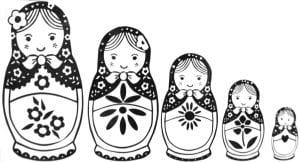Fun Fact: In 1890, the first Matryoshka, or ‘nesting doll’ was carved in Russia. A set of wooden dolls, placed one inside another, each of decreasing size, the ‘nesting doll’ became a popular children’s toy that is now recognizable all around the world!  You may be thinking, “Why is the Writing Center telling me all about nesting dolls?” Well, when a writer draws from multiple sources on a topic to come to a conclusion or unique perspective for their own argument or purpose, it is called Synthesis; and you can visualize synthesis as a nesting doll. Each time we dig into a source, we’re searching for the nuances of that source’s ideas – their thesis or argument, their purpose, criticisms, weaknesses, etc. one doll after another. When we dig deeper and continue to open up the source, we’re bound to unearth something new, down to the finest detail. It is important to pay attention to all of this, particularly as we look for the agreements and disagreements between our sources. We want to consider how these sources fit together, so that we can understand the broader conclusions that can be drawn.
You may be thinking, “Why is the Writing Center telling me all about nesting dolls?” Well, when a writer draws from multiple sources on a topic to come to a conclusion or unique perspective for their own argument or purpose, it is called Synthesis; and you can visualize synthesis as a nesting doll. Each time we dig into a source, we’re searching for the nuances of that source’s ideas – their thesis or argument, their purpose, criticisms, weaknesses, etc. one doll after another. When we dig deeper and continue to open up the source, we’re bound to unearth something new, down to the finest detail. It is important to pay attention to all of this, particularly as we look for the agreements and disagreements between our sources. We want to consider how these sources fit together, so that we can understand the broader conclusions that can be drawn.
If Russian Dolls Aren’t For You, Here Are a Few Other Ways to Think About Synthesis
‘Joining the Conversation’: When we perform synthesis in our writing and engage with making connections, we are joining a wider conversation. We are seeing what has already been said about the topic, seeking out what these many perspectives and viewpoints have in common and/or how they differ, and then interpreting these relationships to form our own input to the conversation. We must directly engage with our sources to draw insightful conclusions and share what we think as a result. ‘Building the Bridge’: Synthesis is building the bridge between your sources for the reader. To synthesize or make connections, we must figure out how we get from one source to the other. In other words, we cannot present our sources in isolation (this wouldn’t help create any new meaning). Instead, we need to build the bridge between source A and source B so that our readers can understand what the two, together, suggest about our understanding of a topic. Then, we build a bridge from this new understanding to source C and source D, and so on.
Start Synthesizing
- Review
So you want to synthesize information? To start, review the existing literature on your selected topic. When searching for resources, aim to collect a number from various authors, subjects, and settings to broaden your understanding of the material – giving yourself more information to consider in the next stage. Ultimately, you’ll want to find the main idea presented in each source, as well as how the author supports or argues against it, as well as why.
- Compare and Contrast
Compare and contrast the main idea found in each source reviewed. What does each perspective have in common? What are their differences? Begin to consider how these sources ‘fit together’ (or, in other words, build the bridge!). During this stage, you may find that some of your collected resources don’t have as much depth or go into as much detail as you’d like. That’s okay, but you’ll want to consider what effect this might have on your ability to draw a meaningful conclusion once synthesized with other source material.
- Ask, What’s the Significance?
By evaluating the quality and significance of each source, you can begin to consider its relevance within the context of your research or in relation to your topic. How does the relationship of one source to another further your understanding of the topic you are focusing on? What is the larger impact of what is being said or argued?
- Infer the Relationship and Draw Conclusions
By this point, you have gone through the existing literature surrounding your subject and compared/contrasted it, finding the main idea of each, as well as their intended purpose, possible criticisms, strengths, and weaknesses. Finally, you have related these ideas to your own research. Although you may have found that your sources agree or disagree on minor (or major) key details, it is the writer’s job to seek the relationship between these sources, put them in conversation together, and draw meaning through analysis. In some cases, you’ll be asked to offer your own perspective or argumentation. Consider, how might you add to the existing conversation?
- Remember
Synthesis is all about meaningful connections, it is not summarizing sources side by side. Before you make larger claims about a topic, make sure you build those bridges between the sources you found through research. Nestle them together. Move beyond summary. Then, you can create an interesting and compelling argument. For additional help, make an appointment with the Writing Center!
Works Cited
Kourakos, Evanthia J. “The Matryoshka-Doll Effect.” Medium, Azure’s Whereabouts, 22 Apr. 2016, medium.com/azure-s-
“Libguides: English Research: Synthesizing Information.” Synthesizing Information – English Research – LibGuides at Aultman Health Sciences Library, aultman.libguides.com/c.php?g=
